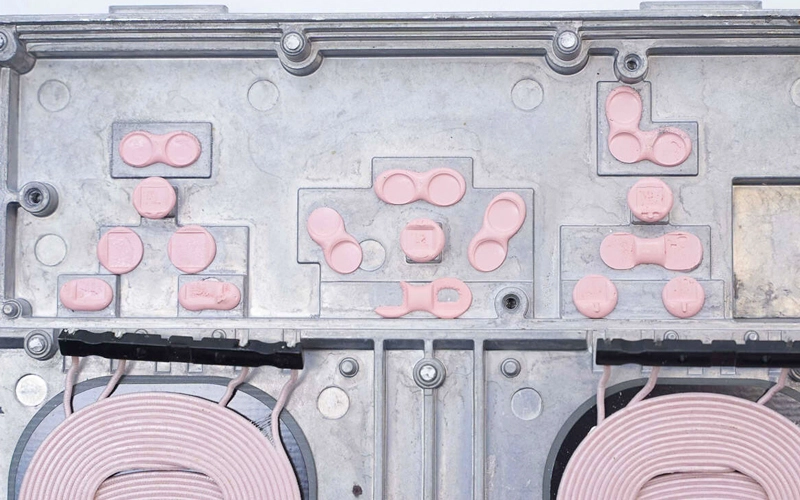Tesla Wireless Charging Module Is Coated with Pink Thermal Putty to Enhance Heat Dissipation and Reduce Temperature Rise
- Posted on:2025-02-11 08:53:00
- Source:AOK Thermal Pad Manufacturer Industry News
The putty helps ensure effective thermal transfer between the components and the aluminum alloy shell. In the case of automotive electronics or similar devices, thermal management is crucial to maintain optimal performance and prevent damage due to excessive heat buildup. The thermal putty fills gaps between components (like chips or circuit boards) and the shell, ensuring better contact for heat flow from the internal parts to the external casing.
This process improves heat conduction and ensures that the overall system remains within safe operating temperatures.Thermal putty or pads like the pink material in the image are often used to enhance thermal conductivity between components, particularly in cases where there are irregular or uneven surfaces that might not make optimal contact with heat sinks or casings.
Here’s how thermal putty works in more detail
1. Thermal Interface
The thermal putty acts as a thermal interface material (TIM), filling the microscopic air gaps between surfaces. Air is a poor conductor of heat, and by replacing these gaps with a material that has better thermal conductivity, heat can move more efficiently from hot components (e.g., processors, ICs) to the heat sink or metal housing (like the aluminum alloy shell).
2. Heat Dissipation Process
a. Heat Generation: The electronic components (like chips, power transistors, or ICs) generate heat during operation.
b. Heat Transfer: The thermal putty helps transfer this heat away from the components by conducting it into the surrounding housing. The aluminum alloy shell, being a good conductor of heat, then disperses it into the environment or through additional cooling mechanisms (like fans or passive cooling).
c. Thermal Management: This thermal dissipation is key to maintaining device reliability and performance, as excessive heat can cause components to degrade or malfunction.
3. Benefits of Thermal Putty
a. Flexibility: Unlike solid thermal pads or pastes, thermal putty has a more flexible consistency, making it easier to apply in areas where components have complex geometries or uneven surfaces.
b. Thermal Conductivity: The material is designed to have high thermal conductivity, helping to efficiently transfer heat to the casing.
c. Gap Filling: It can fill irregular gaps where traditional thermal pads or heat sinks might not be able to make full contact, ensuring a more consistent and effective heat transfer.
4. Applications in Automotive and Electronics
a. In automotive electronics, such as ECUs (Electronic Control Units), sensors, and power electronics, the heat generated by power-hungry circuits can be substantial. Thermal putty helps ensure these components remain within thermal limits to avoid thermal damage.
b. In high-performance computing devices, including processors, GPUs, and power supplies, proper thermal management is essential to avoid throttling or permanent damage.
5. Material Composition
Typically, thermal putties are made from a mixture of silicone compounds and thermally conductive fillers like metal oxides, aluminum, or ceramics. This combination provides good thermal conductivity while still being soft and pliable for easy application.
Overall, the goal of using thermal putty is to ensure that heat from sensitive electronics is efficiently transferred to the surrounding material, thus protecting the components and ensuring long-term stability and performance.
If you would like to learn more about AOK performance thermal materials, please visit our website at www.aok-technologies.com


